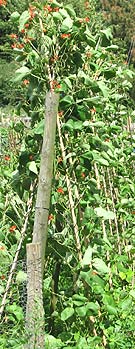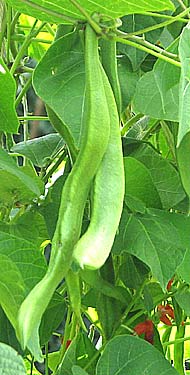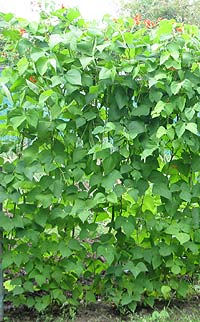Runner Beans
VEGETABLE PAGES
RUNNER BEANS — VARIETIES TO GROW
TALL
Enorma
Achievement
Butler
Fry
Kelvedon Marvel
Sunset
Prizewinner
Painted Lady
Streamline
Scarlet Emperor
Cookham Dene
DWARF
Hammonds Dwarf Scarlet
Hammonds Dwarf White
Pickwick Runner Bean

GARDEN TIP
Green fly can be a real pest but one way to deal with them is to make sure you help the Hoverfly who will actively look for colonies of greenfly to lay their eggs in.
The adults and larvae will eat the Greenfly.
The best way to keep Hoverflies in the garden is to plant sunflowers at different heights.
The hoverflies are attracted to the yellow flowers of the sunflowers and like to hover at different levels looking for nectar.

SOCIETIES

GARDEN TIP
Horsehair gives slugs and snails a very hard time .
They cannot crawl over the hair for two reasons—the hair acts as an irritant and the grease in it reacts with their slime and burns them.
Place the hair in a 4 inch diameter ring around the plant and weight it down with stones.
RUNNER BEANS
 Runner
beans are one of the most popular vegetables in Britain,
coarser in texture with a stronger flavour than French beans.
Runner
beans are one of the most popular vegetables in Britain,
coarser in texture with a stronger flavour than French beans.
Runner beans are heavy croppers and easy to grow and harvest.
These beans are noted for their decorative flowers of scarlet or white.
Most gardeners know the tall growing type that needs stakes and wires for support, but there are also dwarf varieties.
Runner beans are deep rooting so it is advisable to dig more than a spades depth and to bury well rotted manure or garden compost 25cm (10in) deep - one bucketful to every square meter (yard.)
Do this in autumn or winter and choose a sheltered site to encourage insects for pollination.
EARLY CROP RUNNER BEANS
 Runner
beans will not germinate in cold soil.
Runner
beans will not germinate in cold soil.
Sow an early crop variety in seed pots filled with seed compost in April, and use heat to force germination for an early crop in July.
Place the pots in a heated propagator or a warm cupboard until germination has taken place.
Once the runner beans have germinated, transfer to a cold frame or unheated greenhouse away from any danger of frost.
Gradually introduce the plants to slightly colder temperatures.
If the runner bean seedlings are in cold frames lift the glass tops off to allow the air to circulate, and close back up at night if there is any chance of frost.
In warmer parts of the country you can plant out in the second or third week in May.
In colder parts wait until the end of May or even the first week in June.
In Devon and Cornwall it is often possible to sow in April.
In other areas put out cloches in the middle of February to make the soil warm enough for sowing by the middle of March.
SOWING RUNNER BEANS OUTDOORS UNDER GLASS
Put cloches out two weeks before sowing to warm the ground up.
With the hoe make a pair of drills 5cm (2in) deep and 30cm(12in) apart.
Sow the seed 22.5cm (9in)to 30cm (12in) apart
It is a good idea to plant a few extra seeds at the end of each row for transplanting into any gaps that might appear.
Cover over with the cloches immediately - leave in position until all danger of frost has passed.
Remove in mid May or June (in colder parts of the country) and then fix up the supports for the runner beans to climb.
MAIN CROP RUNNER BEANS
The first sowing for the main crop is about the second week in May (South) and third week of May (North).
Using any preferred variety sow the rest of the main crop in succession until the end of June.
In years when there is no early Autumn frosts, runner beans can be picked In years when there is no early Autumn frosts, runner beans can be picked as late as early November.
PLANTING RUNNER BEANS
Before you plant out, it is best to put in position the stakes and other forms of support that the runner bean plants need.
For each peat pot dig a hole. Place the young bean plants close to the inner side of the supporting poles or netting. 15cm (6in) is the minimum distance apart.
For best results 30cm (12in). And if you can fix a sheet of clear plastic to the outside of the supports to a height of about 90cm(3ft) This will help protect the plants from any cold ground winds.
GROWING ROWS OF RUNNER BEANS
Beans like a humid atmosphere to encourage the pollen grains to grow and fertilize the pods.
For this reason it is best to grow a block of three or four short rows. If the ground is kept moist then the microclimate around the plants will encourage the setting of the pods.
Usually runner beans are grown in double rows 30cm (12in) apart.
If more than one double row is wanted, allow a minimum of 1.5meters (5ft) between the rows.
You can sow the seeds directly later in the season either by making separate holes with a dibber 5cm (2in) deep and 22.5cm (9in) apart dropping one seed into the bottom of each hole or by making drills the same depth. Again sow some extra seed at the end of each row for transplanting into any gaps later on.
SUPPORTING RUNNER BEANS
There are many ways to support the runner beans.
Wire netting stretched between posts is one, or to make a decorative display, push six or seven poles into the ground in a circle to meet at the top like a tepee.
Secure tightly with wire or string and sow the seeds at the base of each pole. Or drive 2.4meters (8ft) posts into the ground every 2.4 meters (8ft) and connect strong wire between them, one near the bottom and one at the top.
Then tie upright strings to the wires 11cm (4in) apart for the runners to climb up.
However you choose to support the runner beans, make sure that the structures are really firm. Loose or wobbly supports can seriously affect the plants.
POLLINATION
Runner beans have to be pollinated by insects unlike the French beans.
CARE AND CULTIVATION OF RUNNER BEANS
When the flower buds are green or the first flowers open water thoroughly around the roots and hand spray with water every evening.
When runner beans reach the top of their supports pinch out the growing tips. This will encourage side-shoots and increases flowering.
NEXT: >>>> Harvesting your runner bean crop
OTHER USEFUL ARTICLES ON GARDEN GROWER
| Grow Peppers | When to Plant Autumn Crocus | Lily Beetle | Cyclamen Daffodil | Garden Buildings Hants | How to Grow an Olive Tree| Greenhouse Supplies Beds |
How to grow Runner beans from seed - heavy croppers and easy to cultivate have decorative flowers of scarlet or white. The tall growing variety needs support - there are also dwarf varieties